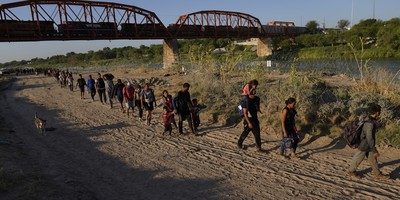More than five decades ago, the wry British humor magazine, Punch, observed that "Idealists maintain that all nations should share the atomic bomb. Pessimists maintain that they will."
Nuclear weapons in the hands of North Korea's hereditary Communist dictatorship vindicate the pessimists.
Yes, a hereditary Communist dictatorship. North Korean dictator Kim Jong Un is the grandson of Kim Il Sung. In 1950, Kim Il Sung invaded South Korea and started the Korean War. He also began North Korea's nuclear weapons program.
In the 1990s the U.S. and South Korea considered three "course of action" options for halting North Korea's nuclear weapons program. They were: 1) enforce stiff economic and political sanctions to isolate the regime; 2) follow a "Wait and see" political and military strategy played with cautious carrot and stick; 3) conduct a pre-emptive air or missile strike on North Korean nuclear research and development sites, weapons stores, missile and air bases and command and control facilities.
Each option had flaws and involved various degrees and types of risk. Option 3 risked reigniting a full-scale war on the Korean peninsula. Communist China remained firmly behind North Korea and Beijing's reaction was unpredictable. Option 3 was put on hold.
Option 2 guided the Clinton Administration's 1994 "Agreed Framework" deal with North Korea. That agreement offered North Korea heavy fuel oil and technical assistance if the Communist regime shutdown its reactors producing weapons-grade plutonium.
The Clinton Administration thought the "soft power" carrot of assistance might convince the dictatorship that cooperation paid.
Recommended
Should Pyongyang violate the agreement, hello Option 1. The U.S. would penalize North Korea by imposing harsh economic and political sanctions.
South Korea's Sunshine Policy, which began in 2000, was another creature of soft power diplomacy and wait and see. The Sunshine Policy would provide North Korea with economic incentives in exchange for economic and political cooperation.
However, in 2002, U.S. intelligence agencies discovered that North Korea had violated the Clinton deal. Pyongyang had a clandestine uranium enrichment program. The Agreed Framework fell apart. The U.S. imposed economic sanctions -- Option 1.
In 2006, North Korea conducted its first nuclear test. South Korea objected strenuously and demanded the dictatorship (now led by Kim Il Sung's son, Kim Jong Il) halt its nuclear weapons program. Pyongyang refused.
In 2008, the South Korean government decided to freeze Sunshine Policy incentives, until the North ended its nuclear weapons program. In March 2010 a North Korean torpedo sank the South Korean warship the Cheonan. 46 sailors died in the incident. South Korean attitudes hardened. In November 2010, South Korea's Unification Ministry terminated the Sunshine Policy.
But Option 2 wasn't dead, not quite. In 2009 the Obama Administration announced that "strategic patience" would guide U.S. policy toward North Korea. Strategic patience amounted to Option 2 with Option 1 sanctions.
In 2011, North Korea began an accelerated ballistic missile test program.
The Obama Administration, however, chose continue to pursue strategic patience.
Since 2011, North Korea has conducted over 30 live-fire tests. Those tests have been productive. North Korea now has extended-range ballistic missiles. Some analysts believe the extended-range missiles can strike Guam and parts of Alaska and possibly the Hawaiian Islands.
In a speech delivered this past January, Kim Jong Un crowed his government would soon have missiles that can target the continental U.S.
The U.S. now deploys several types of advanced anti-ballistic missiles (ABMs). The ABMs offer some degree of protection against a North Korean missile attack. But the ABM shield is a thin shield.
Strategic patience and soft diplomacy failed to end North Korea's nuclear weapons quest. Option 3 involves risks. However, a North Korea armed with long-range ballistic missiles and nuclear warheads is an unacceptable risk.

























Join the conversation as a VIP Member